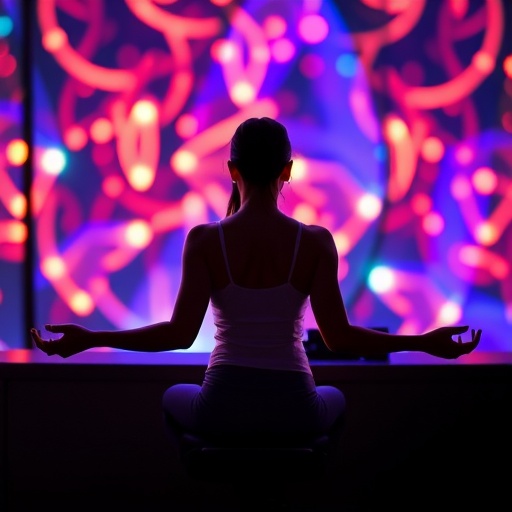In an era where stress permeates daily life with relentless intensity, the search for innovative, effective interventions to manage acute stress has garnered significant scientific interest. A groundbreaking study by Motokawa and Kato, published in the upcoming 2025 edition of BMC Psychology, charts new territory by investigating the synergistic effects of combined vibration and music therapy. This novel approach, blending tactile and auditory sensory inputs, holds promise for those seeking rapid relief from stress, potentially revolutionizing traditional therapeutic practices.
Stress responses, particularly acute stress, trigger complex neurobiological mechanisms that can impair cognitive function and emotional balance. Conventional stress management techniques often rely on psychological or pharmaceutical interventions, each with varying efficacy and side effect profiles. The pioneering work by Motokawa and Kato explores an alternative path—harnessing the physiological and psychological interplay of sensory stimulation to attenuate stress markers without invasive or drug-based methods. Their research meticulously dissects the individual and combined impacts of vibration and music, unveiling an innovative modality that resonates on multiple sensory channels simultaneously.
The study’s first experimental trial examines the isolated effects of vibrational stimuli delivered via specialized equipment designed to emit precise frequencies and amplitudes. These vibrations target mechanoreceptors embedded in the skin and deeper tissues, activating neural circuits implicated in emotional regulation and relaxation. By calibrating the vibration parameters, the researchers sought to optimize the balance between stimulation intensity and relaxation induction, hypothesizing that specific vibrational patterns could mimic or enhance natural bodily rhythms associated with calmness and reduced sympathetic nervous activity.
Parallel to the vibrational intervention, the second trial scrutinized the influence of music therapy, an area well-documented for its psychophysiological benefits. However, rather than employing generic soundscapes, Motokawa and Kato curated bespoke musical compositions that align tempo, rhythm, and harmonic structures with neurophysiological states conducive to stress reduction. These compositions were grounded in neuroscientific principles, aiming to synchronize listener brainwave activity with music-induced theta and alpha rhythms correlated with relaxation and meditative states.
The convergence of these two sensory modalities in combined trials revealed a compelling phenomenon: the integration of vibration and music elicited a more pronounced reduction in cortisol levels—a biochemical hallmark of stress—than either modality alone. These findings underscore the potency of multisensory interventions, suggesting that simultaneous engagement of tactile and auditory pathways can synergistically amplify the therapeutic impact on the stress response system.
Motokawa and Kato’s methodology incorporated rigorous physiological measurements, including heart rate variability (HRV) and galvanic skin response (GSR), alongside subjective self-reports of stress and anxiety. The convergence of objective and subjective data enhanced the robustness of their conclusions. Participants consistently exhibited elevated parasympathetic nervous system activity, indicated by improved HRV, paired with diminished electrodermal activity, suggesting a calming of the autonomic nervous system that governs involuntary stress reactions.
Critically, the study expanded on neuroimaging data obtained through functional near-infrared spectroscopy (fNIRS), revealing heightened prefrontal cortex activation during combined intervention sessions compared to unimodal sessions. This neural signature implicates enhanced top-down regulation of emotional processing during the multisensory experience, highlighting the intervention’s capacity to facilitate cognitive control over stress-induced affective disturbances.
The nuanced interplay between vibration and auditory stimuli also hints at the involvement of the insular cortex, a brain region central to interoceptive awareness and emotional homeostasis. By simultaneously stimulating somatosensory and auditory pathways, the combined intervention appears to recalibrate the neural circuits that underpin subjective stress perception, fostering an embodied sense of calm that aligns with physiological deactivation of stress markers.
From a practical standpoint, the implications of this research extend beyond clinical applications into everyday wellness technologies. Portable devices capable of delivering synchronized vibrational and musical stimuli could soon augment mental health toolkits accessible to the broader population. Envision wearable gadgets that adaptively modulate vibrational intensity and soundtrack selection in real time, personalized to the user’s psychophysiological state, thereby optimizing acute stress mitigation even in high-demand environments like workplaces or transit systems.
Moreover, as digital health platforms proliferate, the integration of combined vibration and music therapy into virtual reality (VR) environments stands poised to redefine immersive stress relief. Multisensory VR interventions that dynamically adjust tactile and auditory stimuli based on biofeedback could open new horizons in psychotherapy, meditation, and performance enhancement, with applications spanning from post-traumatic stress disorder treatment to enhancing focus and resilience in peak performance scenarios.
While the results signal a promising avenue, Motokawa and Kato stress the need for longitudinal investigations to ascertain the durability of stress reduction effects and examine potential habituation phenomena. Additionally, expanding the demographic diversity of study cohorts will be pivotal to understanding the universal applicability of these findings across varying age groups, cultural backgrounds, and clinical conditions.
In conclusion, Motokawa and Kato’s research delivers compelling evidence that the fusion of vibration and music interventions offers a cutting-edge, non-pharmacological strategy for acute stress reduction. By leveraging multisensory stimulation to engage neural networks governing emotional regulation, this innovative approach charts a new path for mental health interventions that are simultaneously grounded in rigorous science and attuned to user experience. As stress-related disorders burgeon globally, this dual-modality modality may emerge as a cornerstone in the evolving landscape of personalized, accessible stress management.
The seamless melding of tactile and auditory interventions marks a paradigm shift, encouraging further exploration of cross-modal therapies to enhance human well-being. The intricate biological pathways unraveled in these studies beckon interdisciplinary collaboration among neuroscientists, psychologists, engineers, and artists to refine and amplify therapeutic outcomes. As this field evolves, the vision of effortlessly integrating science and art in daily stress relief becomes not just achievable, but imminently transformational.
Subject of Research:
Acute stress reduction through combined vibration and music interventions
Article Title:
Exploring combined vibration and music interventions for acute stress reduction: insights from two experimental studies
Article References:
Motokawa, T., Kato, T. Exploring combined vibration and music interventions for acute stress reduction: insights from two experimental studies. BMC Psychol 13, 1100 (2025). https://doi.org/10.1186/s40359-025-03293-9
Image Credits: AI Generated




